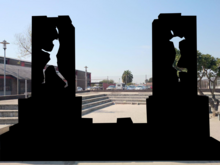

Freedom of panorama (FoP) is a provision in the copyright laws of various jurisdictions that permits taking photographs and video footage and creating other images (such as paintings) of buildings and sometimes sculptures and other art works which are permanently located in a public space, without infringing on any copyright that may otherwise subsist in such works, and the publishing of such images.[1][2] Panorama freedom statutes or case law limit the right of the copyright owner to take action for breach of copyright against the creators and distributors of such images. It is an exception to the normal rule that the copyright owner has the exclusive right to authorize the creation and distribution of derivative works.
- ^ Seiler, David (2006). "Gebäudefotografie in der EU – Neues vom Hundertwasserhaus". Photopresse. p. 16. Archived from the original on September 30, 2007. Retrieved May 18, 2020.
- ^ Rosnay, Mélanie Dulong de; Langlais, Pierre-Carl (February 16, 2017). "Public artworks and the freedom of panorama controversy: a case of Wikimedia influence". Internet Policy Review. 6 (1). doi:10.14763/2017.1.447. hdl:10419/214035. ISSN 2197-6775. Archived from the original on January 18, 2018.
